Water Ecology Test
1/48
There's no tags or description
Looks like no tags are added yet.
Name | Mastery | Learn | Test | Matching | Spaced |
|---|
No study sessions yet.
49 Terms
What are the main parts of the “ice year”?
Freeze up, Main Winter, and Ice Break-Up
What are the main types of river ice?
Frazil ice and Anchor Ice (Dynamic) & Border Ice and Sorface Ice (Static)
What are the main physical effects of river ice on habitat conditions?
Velocity decrease makes middle faster (Ice friction), habitat alteration Light reduction, Dissolved oxygen dynamics, sediment transport and scour.
What ecological effects does river ice have?
Invertebrates: some bugs have cold hardiness and purposely freeze to avoid predators, species specific responses, increased drift during dynamic ice events
Fish: (EGG INCUBATION ice scour and freezing can damage eggs, anchor ice over eggs can reduce oxygen for eggs and they have to get it from ground instead) & (DISTRIBUTION small fish hide in substrates, large fish go to deeper pools, some use ice for cover) (VEGETATION ice scouring and sediment movement change aquatic and riparian plant communities)
What is the concept of stream orders and zonation?
Stream Orders: A hierarchical classification of streams (1st order = headwater streams, Higher orders = formed when lowers order streams merge) as order increases, channel size, discharge, and sediment load increase and gradient generally decreases.
Zonation: Different zones in a drainage basin (Erosion, Transportation, Deposition)
Name some important Canadian rivers, and where does their water flow?
Mackenzie River - Arctic Ocean
St. Lawrence River - Atlantic Ocean
Fraser River - Pacific Ocean
What is the water cycle, and what parts does it have?
the continuous movement of water between the atmosphere, land, and oceans.
Evaporation and Transpiration - water from land water into atmosphere
Condensation - water vapor forms clouds
Precipitation - rain or snow returns to surface
Infiltration and Percolation - water into the ground
Runoff - water flows into rivers and lakes, completing the cycle
What is a river, catchment vs. watershed, and basin?
River - naturally flowing body of water with a current from source to mouth through a gradient
Catchment: The land area where all precipitation drains to a common outlet.
Watershed: Often used interchangeably with catchment; the boundary dividing different catchments.
Basin: A larger-scale area encompassing one or more watersheds that drain into a common outlet (e.g., Hudson Bay Basin). Open area where water collects
What are the 3 dimensions of a river channel?
Lateral – River’s connection with its floodplain and banks
Longitudinal – Flow direction from headwaters to mouth.
Vertical (hyporheic) – Interaction between surface water and groundwater.
Understand the concept of habitat and different scales of habitat
Habitat - The place where a species lives, defined by physical and biological characteristics
Macrohabitat – Large-scale, e.g., entire catchment
Mesohabitat – Visually distinct features like pools, riffles, runs; link species to habitat type.
Microhabitat – Small-scale site measurements (e.g., juvenile fish habitat preferences).
What is a hydrograph and what factors affect it?
Hydrograph - A graph showing river discharge (flow) over time (instantaneous, annual, or multi-year).
Factors
Local climate and season (snowmelt, rainfall).
Catchment topography and geology.
Land use (urbanization, deforestation).
Lakes or wetlands (flow storage or delay).
Human impacts (water withdrawal, dams, regulation).
What is hydropeaking?
Hydropeaking refers to rapid, artificial fluctuations in river discharge caused by hydropower generation, where turbines are turned on/off to meet electricity demand. changing it can mess with the species used to a specific discharge for that time of year
What is the concept of environmental flows?
Environmental flows - “How much water does a river need” describe the quantity, timing, and quality of water flows required to sustain ecosystems and human needs that depend on them. (Summer is the zone of highest risk)
What is substrate, benthos, and biofilm/periphyton?
Be able to explain the difference between the three
Substrate - Underlying layer of organic material, minerals/stone that is on the bottom of a water body.
Benthos - community of organisms that live on or near the bottom of a body of water
Biofilm/Periphyton - community of fungi, bacteria, and algae that reside in a polysaccharide matrix on substrate and act as a food source to many organisms
What are benthic macroinvertebrates (BMIs)?
Be able to name common BMI groups in freshwater
small, aquatic animals and the aquatic larval stages of insects.
Some common groups - sponges, molluscs, worms, shrimp, and insects
What are EPTs?
For these, you must be able to name the scientific name of each Order (E, P, T), and the common name of their order
Ephemeroptera - Mayflies
Plecoptera - Stoneflies
Trichoptera - Caddisflies
What common adaptations do BMI have to life in moving water
flattening/streamlining of the body
hooks and grapples
filtering structures
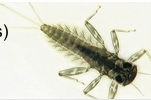
Which of the EPT is this?
Ephemeroptera - Mayflies
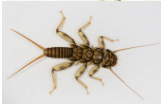
which of the EPT is this?
Plecoptera - Stoneflies
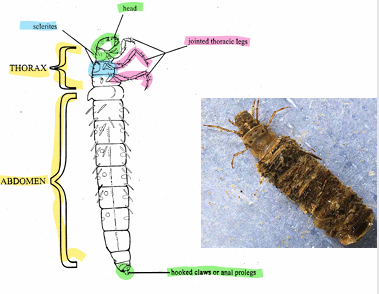
Which of the EPT is this?
Trichoptera - Caddisflies
What habitats might you find BMI?
swift currents
hyporheic zones
slow moving habitat
water surfaces
What is drift, different categories, and what causes drifting?
Drift is the downstream transport of organisms in the water column via active or passive entry.
Categories
Constant drift: Accidental dislodgement of organisms
Catastrophic drift: Caused by environmental disturbances such as floods, droughts, or pollutants.
Behavioural drift: Intentional movement of animals into the water column
Causes
proximal triggers like light (movement at night)
reduced food availability
high density could promote drift (excess production upstream)
Why are BMI’s important?
Indicators of stream/river processes (functional feeding processes)
Indicators of water quality (pollution tolerance, integrate short and long term conditions, relative sedentary)
Important food source for fish
Tracer of historic conditions (they have narrow temperature regimes, so their presence in the sediment can tell you something)
What are functional feeding groups?
Classification of how the BMI feeds (doesn’t mean they are the same type of BMI among said feeding groups)
shredders - feed on course organic matter (leaves) (ex. stonefly)
collectors - Feed on fine organic matter through filtration or gathering (ex. blackfies)
scrapers - Feed of the periphyton (algae) (ex. caddisfly)
predators - carnivores that feed on other invertebrates (ex. dragonflies)
What and how can BMI’s tell about the environment?
Water quality - BMI have different tolerances for water quality, so presence of a certain type could either be a good or bad indicators (you want lots of EPT’s)
Stream/River processes - particularly through feeding types can show nutrient cycling and energy flow in streams
Long term and Short term changes - you can infer environmental conditions due to the BMI’s relative sedentary nature.
What is CABIN, and why is that approach useful?
CABIN (Canadian Aquatic Biomonitoring Network) is a national standard program for assessing aquatic ecosystem health. It uses BMI samples and uses the Reference Condition Approach (RCA) to determine whether a site is “normal” or “impaired.” (EVERYTHING IS COLLECTED THE SAME)
Useful because…
lots of sites
consistent methods
cost efficient
normal vs. impaired assessment
What is a fish?
All are craniates
Most…
live in water
have paired fins
are vertebrates
ectotherms
have gills and jaws
Why study fish?
Indicator of environment
Human nutrition
Economy
Medical research
Tox tests (ex. LD 50)
General importance in ecosystems
Understand diversity of fish and their habitats and basic life history strategies in fish
~35,000 species of fish, if there is water and oxygen, fish will likely be there (11km below sea level or kms above sea level in mountains etc)
Life history strategies :
fast vs. slow water strategies
schooling vs. hierarchical vs. solitary
diurnal vs. nocturnal
migratory vs. resident
site fidelity
Describe what is diadromy (anadromy / catadromy) and give examples of species on both categories, including their life-history stages? (ON TEST FOR SURE)
Diadromy is when a fish spends part of its life in saltwater and part in fresh water
Anadromous fish - born in freshwater, reach adulthood at sea
Catadromous fish - born in ocean, reach adulthood in freshwater
Name examples of common fishes, their characteristics, habitats, population status in temperate parts of North America?
Salmonoids - Anadromous life history, adipose fin, important culturally (Atlantic salmon)
Brook trout - prefers cool water w/ o2, slower water, anadromy
Sturgeons - spiny-rayed fish, secondly derived skeleton (?)
Sea Lamprey - Semelparous, Anadromous, migratory (?)
Striped Bass - Not extinct or endangered
Minnows - 12 NB species, warmwater, small bodied, variety of habitats and habits
Suckers - bottom dwellers, spring spawner, migrations, slow habitat
Sticklebacks - littoral species (area close to shore in pond or lakes where light reaches the bottom), small bodied, 5 species in NB, abundant/common
Name common invasive fish species in NB
Rainbow trout
Small and Large mouth bass
Chain pickerel
What is the potential issue with invasions
They could displace the native fish by competition, they are almost impossible to remove, social acceptance/rejection (“come back” of predators)
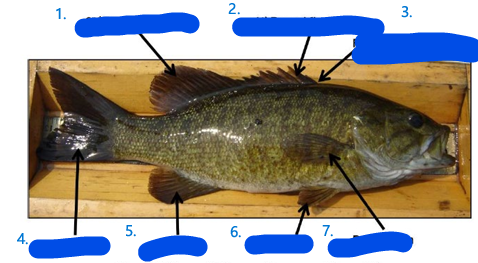
Label
2nd dorsal fin
1st dorsal fin (spiky)
fin insertion or origin
caudal fin
anal fin
pelvic fin
pectoral fin
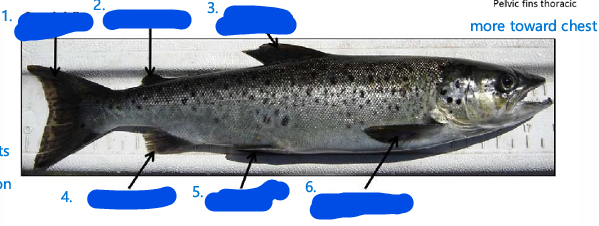
Label
caudal fin
adipose fin
dorsal fin
anal fin
pelvic fin
pectoral fin
What is the role and sources of carbon in rivers?
Provides energy to lotic ecosystems
Sources : Autochtonous inputs (Algae) and Allochtonous inputs (Woody debris/leaves)
What is autochtonous production?
Organic matter produced in the stream
ex. Algae (Perifyton Slimy stuffwith algae, bacteria, fungi etc.. in saccharide matrix*), Macrophytes (Mosses) *Rivers, and Phytoplankton *Lakes and Large Rivers
What is allochtonous production?
Organic Matter produced outside of the stream
ex. Forests, fruits, animal carcasses, sewage and agricultural inputs
Describe forms of organic matter?
(DOM, FPOM, CPOM)
DOM - Fragments so small it is dissolved in to the water (<0.5µm)
FPOM - fragments are very fine, but are actual particles/clumps (<1mm and >5 µm)
CPOM - fragments are just larger that the FPOM (>1mm)
What does autotrophy and heterotrophy mean?
autotrophy - more independent because there is high carbon production, and slower moving dependance of the organic material
ex. Larger Rivers
heterotrophy - dependance on the organic material
ex. Small Headwater
What is River Continuum Concept (RCC)?
A key concept on “how rivers work” by using a predictable continuum (Applicable to the temperate system)
Key Ideas
Physical Envm. - Solar input, temperature, and discharge varies
Biological Envm - Allochtonous inputs dominate upstream, Autochtonous inputs dominate downstream, functional feeding group vary
CRITICISMS - TEMPERATE STREAM BIAS, APPLICABLE TO PRISTINE STREAMS ONLY, PATTERN OF TEMPERATURE CHANGE
Name and describe other river ecosystem productivity models? How do they differ form RCC
Riverine Productivity Model (RPM) - Emphasis on the local processes (Higher P/R ratio on the banks where the light penetration is higher) *Localized little bathtub rings
Flood-Pulse Concept (FPC) - Emphasis on lower flood-plain processes (Pulses are natural predictable disturbances to which biota are adapted, and not having this hydrologic regimen is the real disturbance) *Latitudinal connectivity
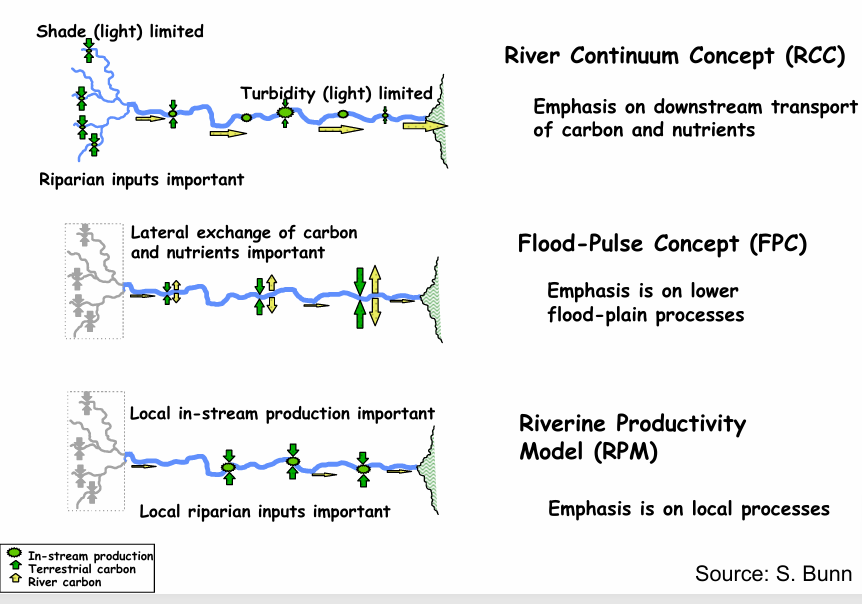
Is the ecosystem efficiency in headwater streams high or low?
Generally Low, most ends up sent to the ocean unprocessed. (its like tossing 50% of your cash away)
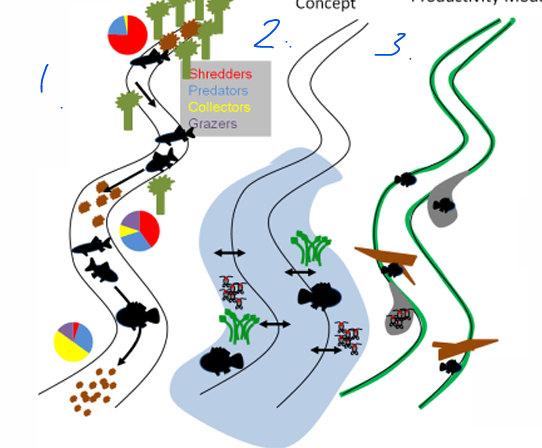
River continuum concept
Flood pulse concept
Riverine productivity Model
What are Marine Derived Nutrients?
Aquatic vectors bring in nutrients and organic material from alternative sources
• Lakes (potamodromous fish; e.g. whitefish)
• Oceans (anadromous fish; e.g. salmon, river herring)
What benefits to different ecosystem components (biofilm, animals, forests) MDN’s have?
MDN’s can provide a boost to N supply for those plants that need it
They provide nitrogen boosts to the forests
Biofilm enrichment boosts grazing insect populations (BMI)
Many species (trout, char, sculpins, insects) consume salmon eggs.
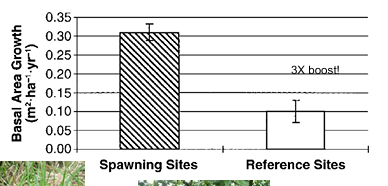
Evidence of MDN’s in West Coast?
Sitka spruce (Picea sitchensis) – 24% of foliar N from salmon (Grew marginally better in spawning areas.
Alders dont really care to use the salmon N because they can fix their own nitrogen
Evidence of MDN’s in East Coast?
while we don’t have as much salmon, we have a greater variety of species… NOT DONE YET
How do MDN’s affect river ecosystem in East Coast?